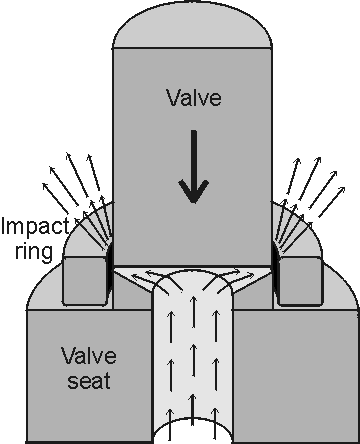|
|
High pressure homogenisersVarious types of high pressure homogeniser are available for use in the food and chemicals industries but the design which has been very extensively used for cell disruption is the Manton-Gaulin APV type homogeniser. This consists of a positive displacement pump which draws cell suspension (about 12% w/v) through a check valve into the pump cylinder and forces it, at high pressures of up to 150 MPa (10 tons per square inch) and flow rates of up to 10,000 L hr−1, through an adjustable discharge valve which has a restricted orifice (Figure 2.5). Cells are subjected to impact, shear and a severe pressure drop across the valve but the precise mechanism of cell disruption is not clear. The main disruptive factor is the pressure applied and consequent pressure drop across the valve. This causes the impact and shear stress which are proportional to the operating pressure.
Figure 2.5. A cross-section through the Manton-Gaulin homogeniser valve, showing the flow of material. The cell suspension is pumped at high pressure through the valve impinging on it and the impact ring. The shape of the exit nozzle from the valve seat varies between models and appears to be a critical determinant of the homogenisation efficiency. The model depicted is the 'CD Valve' from APV Gaulin. As narrow orifices which are vulnerable to blockage are key parts of this type of homogeniser, it is unsuitable for the disruption of mycelial organisms but has been used extensively for the disruption of unicellular organisms. The release of proteins can be described by Equation 2.9 but normally a similar relationship is used where the time variable is replaced by the number of passes (N) through the homogeniser.
In the commonly-used operating range with pressures below about 75 MPa, the release constant (k) has been found to be proportional to the pressure raised to an exponent dependent on the organism and its growth history (e.g., k=k'P2.9 in Saccharomyces cerevesiae and k=k'P2.2 in Escherichia coli, where P represents the operating pressure and k' is a rate constant). Different growth media may be selected to give rise to cells of different cell wall strength. Clearly, the higher the operating pressure, the more efficient is the disruption process. The protein release rate constant (k) is temperature dependent, disruption being more rapid at higher temperatures. In practice, this advantage cannot be used since the temperature rise due to adiabatic compression is very significant so samples must be pre-cooled and cooled again between multiple passes. At an operating pressure of 50 MPa, the temperature rise each pass is about 12 deg. C. In addition to the fragility of the cells, the location of an enzyme within the cells can influence the conditions of use of an homogeniser. Unbound intracellular enzymes may be released by a single pass whereas membrane bound enzymes require several passes for reasonable yields to be obtained. Multiple passes are undesirable because, of course, they decrease the throughput productivity rate and because the further passage of already broken cells results in fine debris which is excessively difficult to remove further downstream. Consequently, homogenisers will be used at the highest pressures compatible with the reliability and safety of the equipment and the temperature stability of the enzyme(s) released. High pressure homogenisers are acceptably good for the disruption of unicellular organisms provided the enzymes needed are not heat labile. The shear forces produced are not capable of damaging enzymes free in solution. The valve unit is prone to erosion and must be precision made and well maintained.
This page was established in 2004 and last updated by Martin
Chaplin |

 (2.10)
(2.10)